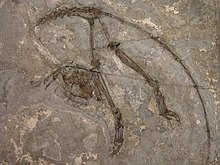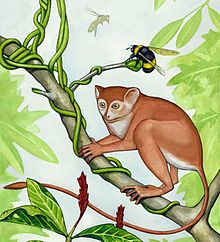Archicebus
| Archicebus | |
|---|---|

| |
| Holotype | |
| Scientific classification | |
| Domain: | Eukaryota |
| Kingdom: | Animalia |
| Phylum: | Chordata |
| Class: | Mammalia |
| Order: | Primates |
| Suborder: | Haplorhini |
| Infraorder: | Tarsiiformes |
| Family: | †Archicebidae Ni et al. 2013 |
| Genus: | †Archicebus Ni et al. 2013 |
| Species: | †A. achilles
|
| Binomial name | |
| †Archicebus achilles Ni et al. 2013
| |
Archicebus is a
common ancestor of all haplorhines as well as the last common ancestor of all primates.[5] Its discovery further supports the hypothesis that primates originated in Asia, not in Africa.[6]
Etymology
Archicebus achilles was named for being the oldest-known primate skeleton (as of 2013[update]) and for its distinguishing
arche (ἀρχή), the Ancient Greek word for "beginning", and cebus, the Latin version of the Ancient Greek kêbos (κῆβος), which refers to a long-tailed monkey. The species name, achilles, is a reference to Achilles, the Greek hero of the Trojan War from Greek mythology.[7]
Evolutionary history
Archicebus achilles exhibits similarities with
tarsiiform clade within the suborder Haplorhini. Considering its age, and since simians are a sister group to tarsiiforms, A. achilles may closely resemble the common ancestor of haplorhines and possibly the last common ancestor of all primates.[8]
| Phylogeny of primates[9] | ||||||||||||||||||||||||
| ||||||||||||||||||||||||
| According to Ni et al. 2013, Archicebus is a basal member of the clade containing tarsiers, making it a close relative of monkeys and apes. |
Biogeography
The discovery of A. achilles adds further support to the hypothesis that primates originated in Asia, and not in Africa, with many
simians (a group of them) migrating to the latter continent thereafter.[3]
Anatomy

A. achilles is estimated to have weighed 20 to 30 g (0.7 to 1.1 oz), making it comparable in size to today's smallest living primates, mouse lemurs.[9]
Range and ecology
A. achilles lived in the forests of the warm Eocene epoch, approximately 55.8 to 54.8 million years ago in a part of Asia near what now is Jingzhou, in the southern Hubei Province of China.[2][3][7]
Judging from its large
Teilhardina asiatica. Its hind limbs suggest it did a lot of leaping; however, its hips, shoulders, and feet also suggest that it was not a vertical clinger and leaper such as tarsiers and galagos are, but likely moved through the trees in a more generalized quadrupedal fashion by grasping tree limbs from above.[8]
References
- ^ Ni et al. 2013, pp. 2 (sup).
- ^ Ifeng.com. Retrieved June 10, 2013.
- ^ a b c Wilford, J. N. (June 5, 2013). "Palm-size fossil resets primates' clock, scientists say". The New York Times. Retrieved June 5, 2013.
- ^ Jha, Alok (June 5, 2013). "Tiny, insect-eating animal becomes earliest known primate". The Guardian. Retrieved June 7, 2013.
- ^ a b Landau, Elizabeth (June 5, 2013). "Ancient primate could be a missing link". CNN. Retrieved June 7, 2013.
- ScienceNow. Archived from the originalon June 8, 2013. Retrieved June 7, 2013.
- ^ a b Ni et al. 2013, p. 60.
- ^ a b Ni et al. 2013, pp. 63–64.
- ^ a b Ni et al. 2013, p. 63.
Literature cited
- Ni, X.; Gebo, D. L.; Dagosto, M.; Meng, J.; Tafforeau, P.; Flynn, J. J.; Beard, K. C. (2013). "The oldest known primate skeleton and early haplorhine evolution". Nature. 498 (7452): 60–64. S2CID 4321956.
External links
- Primate skeleton could give clues about human origins (BBC News)
- Gron, Kurt J. (July 2008). "Primate Factsheets: Tarsier (Tarsius) Taxonomy, Morphology, & Ecology". National Primate Research Center, University of Wisconsin–Madison.
